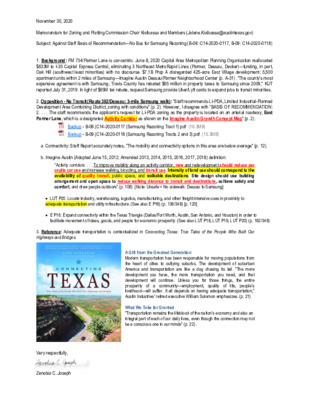B-08 and B-09 (Citizen Comment).pdf — original pdf
Backup

November 30, 2020 Memorandum for Zoning and Platting Commission Chair Kiolbassa and Members (Jolene.Kiolbassa@austintexas.gov) Subject: Against Staff Basis of Recommendation—No Bus for Samsung Rezoning (B-08: C14-2020-0117, B-09: C14-2020-0118) 1. Background: FM 734/Parmer Lane is car-centric. June 8, 2020 Capital Area Metropolitan Planning Organization reallocated $633M to I-35 Capital Express Central, eliminating 3 Northeast MetroRapid Lines (Parmer, Dessau, Decker)—funding, in part, Oak Hill (southwest least minorities) with no discourse. $7.1B Prop A disregarded 425-acre East Village development; 5,500 apartment units within 2 miles of Samsung—Imagine Austin Dessau/Parmer Neighborhood Center (p. A-31). “The county's most expensive agreement is with Samsung; Travis County has rebated $65 million in property taxes to Samsung since 2009,” KUT reported July 31, 2019. In light of $65M tax rebate, request Samsung provide Uber/Lyft cards to expand jobs to transit minorities. 2. Opposition - No Transit (Route 392/Dessau: 3-mile Samsung walk): “Staff recommends LI-PDA, Limited Industrial-Planned Development Area Combining District, zoning with conditions” (p. 2). However, I disagree with “BASIS OF RECOMMENDATION: 2. . . . The staff recommends the applicant’s request for LI-PDA zoning as the property is located on an arterial roadway, East Parmer Lane, which is a designated Activity Corridor as shown on the Imagine Austin Growth Concept Map” (p. 2). Backup - B-08 (C14-2020-0117 (Samsung Rezoning Tract 1).pdf (16.3MB) Backup - B-09 (C14-2020-0118 (Samsung Rezoning Tracts 2 and 3).pdf (15.3MB) a. Connectivity: Staff Report accurately notes, “The mobility and connectivity options in this area are below average” (p. 12). b. Imagine Austin (Adopted June 15, 2012; Amended 2013, 2014, 2015, 2016, 2017, 2018) definition: “Activity corridors . . . To improve mobility along an activity corridor, new and redevelopment should reduce per capita car use and increase walking, bicycling, and transit use. Intensity of land use should correspond to the availability of quality transit, public space, and walkable destinations. Site design should use building arrangement and open space to reduce walking distance to transit and destinations, achieve safety and comfort, and draw people outdoors” (p. 106). [Note: Unsafe = No sidewalk: Dessau to Samsung] LUT P20. Locate industry, warehousing, logistics, manufacturing, and other freight intensive uses in proximity to adequate transportation and utility infrastructure. (See also E P16) (p. 136/348) [p. 120] E P16. Expand connectivity within the Texas Triangle (Dallas/Fort Worth, Austin, San Antonio, and Houston) in order to facilitate movement of ideas, goods, and people for economic prosperity. (See also LUT P18, LUT P19, LUT P20) (p. 162/348) 3. Reference: Adequate transportation is contextualized in Connecting Texas: True Tales of the People Who Built Our Highways and Bridges. A Gift from the Greatest Generation Modern transportation has been responsible for moving populations from the heart of cities to outlying suburbs. The development of suburban America and transportation are like a dog chasing its tail. “The more development you have, the more transportation you need, and that development will continue. Unless you for those things, the entire prosperity of a community—employment, quality of life, people’s livelihood—will suffer. It all depends on having adequate transportation,” Austin Industries’ retired executive William Solomon emphasizes. (p. 21) What We Take for Granted “Transportation remains the lifeblood of the nation’s economy and also an integral part of each of our daily lives, even though the connection may not be a conscious one in our minds” (p. 22). Very respectfully, Zenobia C. Joseph